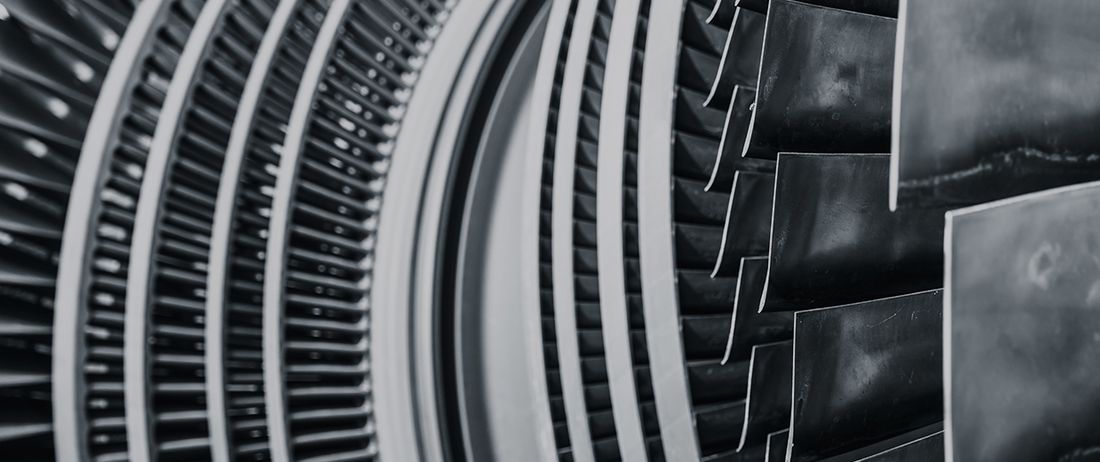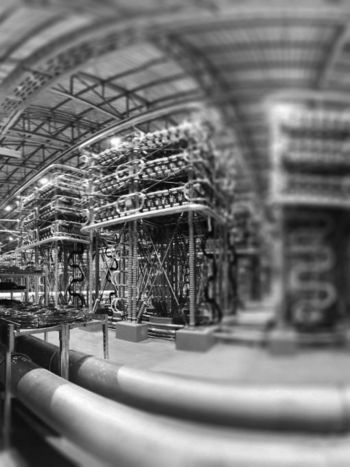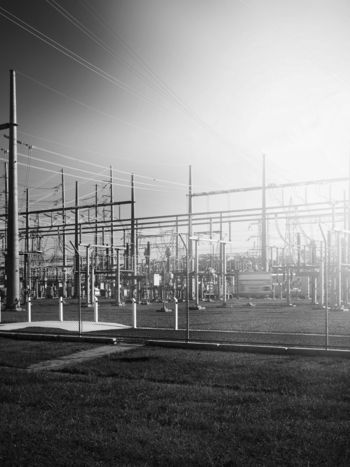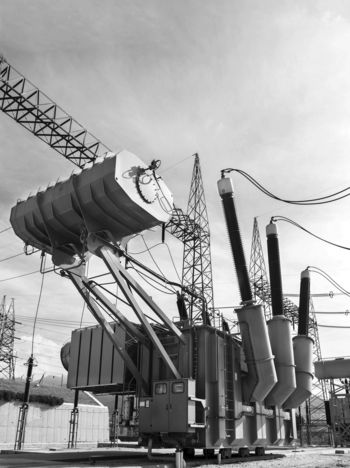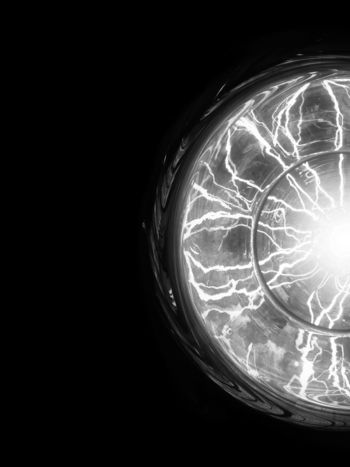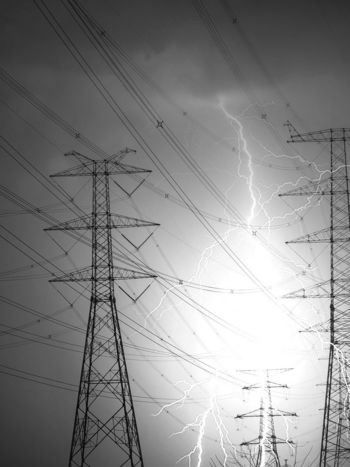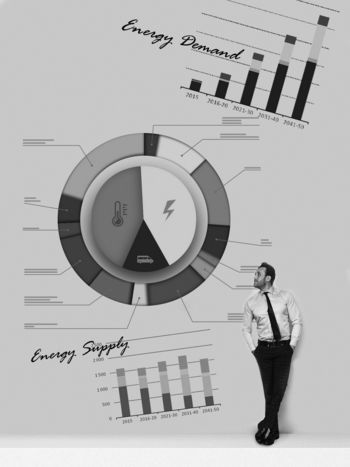Effectiveness of line surge arresters for lightning protection of overhead transmission lines
The importance of lightning protection of overhead lines increases with social demand for power supply quality. Applying metal-oxide surge arresters to overhead transmission lines became a state-of-art technique for lightning protection; however, more knowledge and further experiences to utilize arresters still needs to be shared among the engineers worldwide. The Technical Brochure by WG C4.39 intends to provide such information for the more effective implementation.
Convenor
(JP)
K. TSUGE
Secretary
(JP)
M. MIKI
R. BIANCHI LASTRA (AR), A. SANDRO DE CASTRO (BR), J. HOLLMAN (CA), W. CHANDRASENA (CA), J. HE (CN), Y. YU (CN), V. HINRICHSEN (DE), W. SOERRIES (DE), M.A. JIMENO HIDALGO (ES), D. MARIN (FR), L. DIAZ (FR), E. VOLPOV (IL), Y. ISHIZAKI (JP), T. UEDA (JP), A.K. ZAINAL (MY), I.M. RAWI (MY), B. JOHNNERFELT (SE), M. BECAN (SI), A. KERI (US), R. FREEMAN (US), J. WOODWORTH (US), S. PANIGRAHI (US), K. KLEINHANS (ZA)
Corresponding Members: T. DALY (AU), B. KRUSKA (DE), F. YAPRAKDAL (TR), M. ISHII (JP), J.R. DACONTI (US)
Metal-oxide surge arresters have superior protective performance against overvoltages in power systems due to their excellent non-linear voltage-current characteristics as shown in Figure 1. While the surge arresters suppress overvoltages in substations, lightning-caused faults sometimes occur in transmission and distribution lines. Then the countermeasures such as reduction of tower footing resistance, multiple overhead grounding wires, reduction of shielding angle and increasing line insulation level have been implemented to mitigate the risk of lightning-related outages.
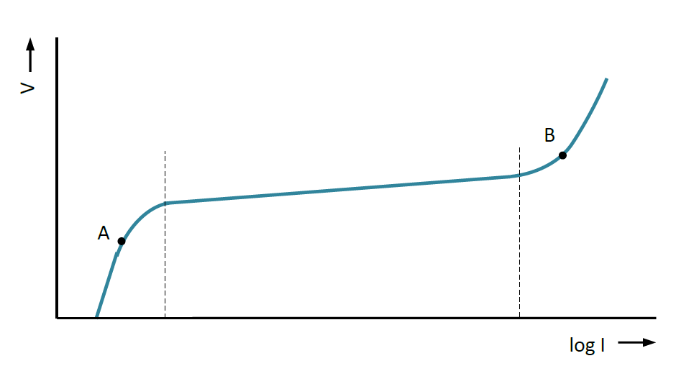
Figure 1 - Voltage-current characteristics of metal-oxide surge arrester
As is widely proven, metal-oxide surge arresters have an essential potential to improve insulation coordination against lightning overvoltages in transmission and distribution networks because of the fact that their protective performance frequently results in better techno-economical effect vs. those conventional countermeasures stated above.
In some countries social demand for power supply quality against lightning has expanded the use of line surge arresters (LSA). The established unique LSA-design concept and testing technology were standardized and an IEC standard for externally gapped line surge arresters (EGLA) was first time established in 2011 [IEC 60099-8, 2011]. The IEC standard dedicated to LSAs including non-gapped line surge arresters (NGLA) and EGLA is currently under development by a project team in IEC TC37. Thus, the IEC standard of application and selection recommendations for surge arresters [IEC 60099-5, 2018] is expected to provide the updated information for these LSAs.
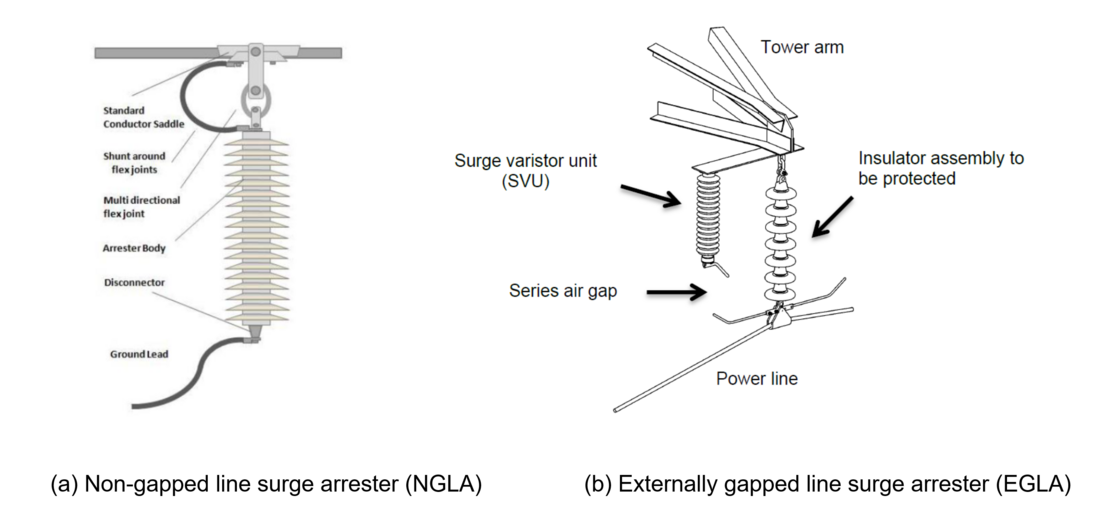
Figure 2 - Line surge arresters (LSA)
CIGRE TB 440 “Use of Surge Arresters for Lightning Protection of Transmission Lines” [CIGRE, 2010] provides basic information on LSA design and application including typical case-studies for analytical approach. Since the brochure was published a decade ago, installation of LSA was further extended and the expanding field experience needs to be shared. The relevant technical issues, which have not been addressed in the brochure, should also be investigated for effective implementation of LSA. Thus, the following technical aspects presents basis and motivation of the CIGRE WG C4.39 activity.
a) Application experience of LSA
LSAs are often applied to existing lines. Considering upgrade of lightning protection performance of such lines, it is preferred to investigate effective implementation and operation of LSAs. However, LSAs have not been commonly used in transmission and distribution lines except for some countries, hence the necessary technical information such as critical characteristics of LSA, how LSA can be applied and what effectiveness can be expected etc., may be limited. Therefore, it is worth summarizing the field experience in the countries where LSAs have been applied in advance, to acquire useful knowledge and to share it among the engineers in the world.
b) Implication of the recent lightning studies
Recently, lightning studies on the characteristics and parameters such as ground flash density, stroke current and charge transfer etc. have progressed. In particular, CIGRE TB 549 “Lightning Parameters for Engineering Application” [CIGRE, 2013] summarizes results of such studies over more than three decades. Thus, the recently acquired knowledge should be considered for evaluating line lightning performance with LSA.
c) Modeling approaches and simulation techniques for line protection performance assessment
Analysis techniques and various numeric approaches for lightning surges simulation in power systems have been established in recent decades. While the analytical practice is getting more common as the modeling tools such as Electromagnetic Transients Program (ATP-EMTP) and IEEE Flash etc. became popular. The CIGRE TB 440 [CIGRE, 2010] gives an introduction and commonly accepted methodology for such an analysis involving LSA, as well as basic information on LSA itself. CIGRE TB 543 “Guideline for Numerical Electromagnetic Analysis Method and its Application to Surge Phenomena” [CIGRE, 2013 (2)] discusses limitations of EMTP and introduces NEA methods as the better solution. The Full-wave EMF-FDTD Techniques still far from practical use as they require a lot of elaborations in particular, regarding modeling accuracy for practical installations including LSA.
d) Implication of lightning location system (LLS)
LLS have become popular in many countries to monitor lightning incidence to power networks with mapping data of located stroke points or to investigate lightning-tripout risk from the locally accumulated data. Recently in some countries, several LLS have been connected/integrated into a lightning detection network aimed at providing the national or continental wide monitoring of lightning activity. Ground flash density (GFD) can be determined from the detection data instead of conventional keraunic levels. Considering recent technology improvement on locating accuracy, estimating peak current and lightning detection network structure, LLS are expected to support effective application of LSA by estimating local flash density of the line for LSA installation or locating the stroke point where LSA overload is suspected.
Content of the TB
The goal of the Technical Brochure is to provide the latest aspects on LSA applications. CIGRE WG C4.39 had determined the engineering tasks to the goal, which covered investigation on lightning stress, LSA designs, field experience, protection performance, and LLS application. With these tasks, the working group has worked to address technical information intended for effective LSA application. The information in the brochure has been represented by the following contents.
Lightning aspects for LSA application
The results of the latest lightning studies are briefly summarized. And in particular, lightning strokes sequence, parameters related to LSA application and typical lightning fault scenarios expected on overhead transmission and distribution lines. Then important lightning parameters for determining LSA design and analyzing LSA performance to protect overhead transmission and distribution lines are addressed.
What is an LSA?
The LSA are surge arresters which have intentionally been designed for installation directly on transmission or distribution overhead lines. They can be classified into NGLA, EGLA and current limiting gaps (CLG) design categories. Typical characteristics, performance and how these LSA are used are introduced. These subjects include design, lightning energy handling capability, protective characteristics against lightning and critical issues to be considered. The presented data provides basic understanding and useful information for effective LSA implementation.
Lightning charge transfer duty for LSA
In the latest IEC and IEEE standards for surge arresters a new testing method to evaluate charge transfer capability and related energy handling duty was established. However, not enough information on necessary LSA lightning charge transfer duty has been available so far for service application. Thus, the required charge-transfer duties for typical LSA applications have been examined based on lightning studies and analyses.
Field experience with LSA application
An international survey was conducted over several countries where LSA are expected to be in service in order to protect overhead transmission and distribution lines. The questionnaire response on LSA effectiveness is summarized including critical issues, and specific experience in some countries are also introduced, aimed to share useful information among the Arrester-application engineers.
Numerical approaches
Basic information on the present modeling tools for lightning surge analysis and general analysis procedures to evaluate LSA effectiveness are introduced and discussed. Then the LSA effectiveness against lightning overvoltage is analytically evaluated for typical LSA applications. Some simulation results being obtained with typical modeling tools which are based on circuit theory and Numerical Electromagnetic Analysis (NEA) solution have also been discussed.
LLS for LSA application
LLS have the potential to be utilized for LSA application. Recent technology trends of LLS such as improved performance to locate stroke point and to estimate lightning peak current are introduced. Then the possibility of LLS for LSA application is discussed, including field experience with LLS from the international LSA survey.
Special thanks
Regarding international survey on LSA field experience, CIGRE WG C4.39 expresses special thanks to the LSA users from Brazil, Canada, Croatia, France, Japan, Malaysia, Slovenia, South Africa, and Thailand, who provided the response for our questionnaire.
